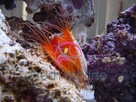Derasa Clam Cultured - Tridacna derasa - Smooth Giant Clam
Medium 2" - 3"
Large 3" - 4"
X-Large 4" - 6"

Taxonomy: Derasa Clam Cultured belongs to the Kingdom Animalia, Phylum Mollusca, Class Bivalvia, Family Tridacnidae, Genus Tridacna and Species derasa.
Scientific names: The scientific name of Derasa Clam Cultured is Tridacna derasa.
Other common names: Derasa Clam Cultured is also commonly known as Smooth Giant Clam and Southern Giant Clam.
Origin or natural range: Tridacna derasa originates in the Indo-Pacific region including the Great Barrier Reef.
Size: Derasa Clam Cultured may grow up to a size of approximately twenty inches.
Color: Tridacna derasa occurs in Brown, Tan, Yellow, Orange, Green, Black, White and Blue colors.
Aggression: Derasa Clam Cultured is generally non-aggressive towards the marine aquarium invertebrates.
Venom status: Tridacna derasa is non-poisonous in nature.
Habit & Habitat: Derasa Clam Cultured is found in abundance in its natural habitat.
Hardiness: Tridacna derasa is quite hardy.
Morphology:
- The shell of Derasa Clam Cultured is thick and smooth with approximately six to seven vertically aligned folds.
- In captivity, bony plates, called Scutes, may grow on the body surface of Tridacna derasa.
- The mantle of Derasa Clam Cultured is varied in color and is patterned with spots or wavy lines.
- The siphon or the tube facing the water incurrent has tentacles.
Growth enabling environment in your marine aquarium: Aquarium habit & habitat:
- Tank type: To host Derasa Clam Cultured, you should have a well established Reef Type Marine Aquarium.
- Aquarium set-up: Keep corals or rocks, coral rubble and a thick layer of sand in your marine aquarium for the Tridacna derasa to burrow in.
- Water flow in the aquarium: Derasa Clam Cultured needs moderate water current in the reef tank it inhabits.
- Temperature of water: Seventy-two to seventy-eight degrees Fahrenheit.
- Specific gravity of water: 1.023 to 1.025.
- pH of water: 8.10 to 8.40.
- Illumination: Derasa Clam Cultured requires high intensity lighting in the marine aquarium hosting it.
- Power Compact, Metal Halide or Daylight Fluorescent Tube lightings are recommended for Tridacna derasa.
- Placement: Superficially bury a flat rock in the sand of your marine aquarium and place the Derasa Clam Cultured on the sand covered rock. The clam will soon anchor itself to the rock.
- Growth in aquarium: In captivity, Tridacna derasa can grow to double or to triple of its original size, within a year.
- Diet: Derasa Clam Cultured is Planktivorous in feeding habit.
- Food content: Tridacna derasa derives its nutrition mainly through photosynthesis, which is performed by Zooxanthellae, a photosynthetic algae living within the mantle of the clam. Derasa Clam Cultured also eats phytoplankton.
- Supplements:Supplement the diet of Derasa Clam Cultured with the liquefied yeast.
- Add Calcium, Strontium, Iodine and Trace Elements to the tank water as the health supplements for the Tridacna derasa in it. Maintain the Calcium level between four hundred grams per liter and four hundred and eighty grams per liter of aquarium water.
- Derasa Clam Cultured is moderately difficult to maintain.
- Blennies, Clown Gobies, Butterfly Fish, Angelfish and Shrimps in your marine aquarium may attack Tridacna derasa therein. Therefore, do not keep the clam and these aggressive marine invertebrates in the same tank.
- Adequate lighting in a marine aquarium is very crucial for the growth, color and the life of Derasa Clam Cultured therein.
- Tridacna derasa requires Nitrogen for its growth. Keep the Nitrates level in the marine aquarium water within two milligrams per liter.

Electric Flame Scallop - Lima species - Electric Eye Flashing Scallop
Freshmarine: $24.99
You Save 37.51%
Before Placing Your Order
Store InformationShipping Info
Payment Info
Return Policy
Arrive Alive Guarantee
Adoptation Policy
After Placing Your Order
Track Your OrderSecurity Safe Shopping
Compatibility Chart
Shoppers Review









